
Google recently launched a localised (.pk) version of YouTube in Pakistan. Many celebrated the development, while a few raised eyebrows. Most thought it now implied a smooth return of YouTube to Pakistan after the hiatus of over three years. But guess what: YouTube’s official entrance is still pending.
While it was available through some ISPs on the day of the launch, the next day, youtube.com.pk too displayed the very familiar ‘Surf Safely’ sign.
Pakistan to lift official YouTube ban within days
Looking back
The saga began back in September 17, 2012, when then Prime Minister Raja Pervez Ashraf ordered YouTube be banned in Pakistan.
In 2013, two petitions were filed challenging the ban on YouTube: one before the Peshawar High Court and another before the Lahore High Court (LHC). A third petition was filed in 2014 before the Sindh High Court, challenging censorship on the internet while also bringing into question the YouTube ban. Of these, proceedings before Justice Mansoor Ali Shah in the LHC were the most extensive.
When in 2013 the federation was questioned in the LHC, as to who ordered the ban, the counsel said it was the Inter Ministerial Committee for the Evaluation of Websites (IMCEW) that had ordered the “IP-level blocking of YouTube.” This was submitted to court in writing. If the ban was imposed by the IMCEW, given that the prime minister disbanded it in March 2015, shouldn’t its dissolution undo all directives issued by it? Especially when the directives can’t possibly be binding if the IMCEW was a mere ‘recommendatory body’ as maintained by the Ministry of Information Technology and Telecom Affairs (MOITT) counsel during proceedings in the Islamabad High Court (IHC) in January 2015.
This statement came in response to Justice Athar Minallah’s question on where the IMCEW drew the authority to issue blocking directives, in a case challenging the committee’s legality and constitutionality. The PTA’s powers also stand challenged in the same case – still pending before court.
PTA petitions top court against YouTube ban
The role of LHC
Great strides were made in the LHC to gain clarity on the issue - the court went to great lengths to seek public and expert input. The legislature played its part. In 2014, the National Assembly unanimously passed a resolution recommending the ban be lifted. The Senate’s Functional Committee on Human Rights also passed a unanimous resolution. But the Ministry found a door to escape.
To every query sent its way on the ban – in court, in the assemblies, through the media – it would state: YouTube is blocked upon the orders of the Supreme Court (SC). This was the line it took before the LHC; in a statement issued by the PM’s office in response to a letter by Senator NasreenJalil on the ban. It is what the Cabinet Division’s response was to MNA Shazia Marri and Senator Osman Saifullah Khan, to questions they had submitted on the YouTube ban in the National Assembly and Senate, respectively.
The 2012 SC order, issued by a three-member bench headed by then Chief Justice Iftikhar Chaudhry and comprising Justice Arif Khilji and Justice (retd) Jawwad S Khwaja, being referred to did not direct the government or PTA to block YouTube.com. Instead, their directions were to remove “offending material” from YouTube and any other website.
And that’s how the discussion started in the LHC as well: how could the video be removed but access to YouTube restored. A year on, after delving into the policy, technology and legal aspects of it all – making the distinction between HTTP and HTTPS – Justice Mansoor Ali Shah and Justice Atir Mahmood stated in their May 2014 order: “From the report of the Ministry, as well as experts, it appears that the most feasible option that requires consideration is the introduction of ‘Interstitial warning’ with full access to YouTube.”
Will localised version of YouTube change anything for Pakistan?
Fighting technology was not recommended; interstitials as a solution to the ban and self-regulation at the home level for offensive content on the Internet in general, was. Justice Mansoor Ali Shah’s July 2013 interim order provides much-needed perspective on this. The Ministry could have gone back to the SC in 2014 with what was established before the LHC, if it really wanted to lift the ban on YouTube – and if it believed the ban was a result of the SC order. Did it? No.
Instead, it adamantly pursued the localisation of YouTube. Anything short of being able to control this medium was just not a palatable solution for it – never mind what the court or legislature held, or experts offered.
While the Ministry neither went to court nor issued any public statement on the launch of .pk, according to news reports, the PTA has now approached the SC, asking that the ban on YouTube be lifted after the launch of a .pk domain where the offending material is not available. Then why is .pkblocked at all? Upon whose orders? There’s no IMCEW. The court never said so. Who is sitting and making these decisions?
When will YouTube officially return - and what version of it – is an answer we still don’t have. The fate of YouTube and citizens’ access to information online hangs in the fray a while longer. More worrying is on what terms – and whose terms – will this question be settled.
The writer is a journalist and co-founder and director of Bolo Bhi, a digital rights and advocacy group
Published in The Express Tribune, January 18th, 2016.
Like Business on Facebook, follow @TribuneBiz on Twitter to stay informed and join in the conversation.

















COMMENTS
Comments are moderated and generally will be posted if they are on-topic and not abusive.
For more information, please see our Comments FAQ